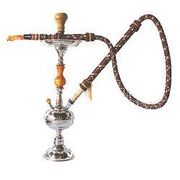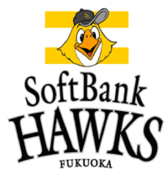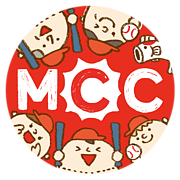- 詳細 2023年7月1日 08:08更新
-
シーシャ(水タバコ)は中東の伝統的な喫煙具です。
water pipe, nargeela/arghileh/nargile, shisha/sheesha, kalyan, ghelyoon or Ghalyan, hubble-bubble等の異名があります。
ノンタールでニコチンはわずか0.5%以下の非常に軽いタバコです。
有害性は低く、煙は甘くフルーティーでその種類はアップル、コーヒー、バナナ、チェリーと幅広くあります。
1時間程吸えるので、お酒やお茶を飲みながらゆっくりと楽しみます。
Hookahs are water pipes like bongs, but are not intended for the use of marijuana. There are four fundamental parts of a hookah:
the base or smoke chamber, which is partially filled with water
the bowl, which contains the tobacco (or whatever else is being smoked); the heating apparatus is placed on top
the pipe, which connects the bowl to the base by a tube that plunges into the water
the hose, which connects to a second tube in the pipe that does not plunge into the water, but only the air of the smoke chamber
These basic parts do not vary in function; naturally, there are any number of decorations or subtle variations in form. The heating apparatus is usually charcoal, but in Saudi Arabia and the Persian Gulf, electric heaters are common. The charcoal is usually placed on a metal mesh or perforated aluminium foil, but these are often omitted to produce a more dense smoke. The hose may or may not be detachable — simple hookahs simply have a tube into the air of the smoke chamber; elaborate hookahs have three or more hoses in a single chamber, with filters attached at one or both ends of the hose.
The most commonly-used hookah tobaccos (known as tobamel or maassel) are produced using a 1:2 mixture of shredded tobacco leaf mixed in with a sweetener such as honey, molasses or semi-dried fruit. Originally, tobacco was mixed with one of these sweeteners to form jurâk (e.g. Zhaghoul brand), a flavorless, moistened tobacco. The now-popular, fruit-flavored hookah tobaccos got their start in the late 1980s when Egyptian tobacco companies began experimenting with flavored tobacco as a way to sell more of their products to women. Due to the popularity of flavored hookah tobaccos, many modern manufacturers have begun to use glycerin as the primary sweetener in hookah tobaccos because of its humectant qualities and subtle sweetening properties that accentuate the various tobacco flavorings. Today, shisha tobacco is often mixed with dried fruit, natural extracts and artificial flavorings to produce a varying assortment of tobacco flavors, such as apple, strawberry, mango, cappuccino, vanilla, coconut, cherry, grape, banana, mixed fruit, cola, lemon, apricot, and mint, which has a cooling effect on the throat. This proliferation of flavors is rather new, starting perhaps in the mid-1990s.
The design of a hookah allows for multiple hoses to lead to a single filtration chamber; this simplifies use by groups. (Too many hoses, however, reduces suction, and smokers may have to cover their mouthpiece while not in use.) Multi-hose hookahs are particularly popular in the Western world, where hookah smoking is a social phenomenon. They are not as common in Asia and Africa.
In Arab society, social smoking is done with a single hose: when the smoker is finished, either the hose is placed back on the table signifying that it is free, or it is handed from one user to the next, folded back on itself so that the mouthpiece does not point at the person receiving it. The receiver taps or slaps the giver on the back of the hand while taking it. In cafes or restaurants, however, it is common for each smoker to order an individual hookah.
In Spain, the use of the hookah has been recently increasing in popularity, and they are usually readily available at tea-oriented coffee houses, called "teterías" in Spanish, which often are run by Muslim immigrants or have some other sort of affinity with the east. Hookahs are usually sold at prices between 25 and 60 euros, and hookah tobacco and charcoal is easily found in those same coffee houses, or at stores run by eastern immigrants. Immigrants and native spanish alike enjoy this custom, and it's usually seen as a lighter way of smoking than cigarettes. Buying your own tobacco and hookah is, usually, noticeably less expensive than ordering hookahs at a coffee house.
In Israel, the hookah (most commonly reffered to as a nargilah (nargeela) is prevalent among Israeli Arabs and Jewish immigrants from places like Yemen, Iran, Iraq and Turkey. Usage of the hookah is also popular in Israeli society at large where smoking is already a cultural norm. Hookahs can be found at some coffee houses, restaurants and more recently, at outdoor concerts and nightclubs. Some nightclubs even offer the option of renting hookahs. For example patrons at club Vertigo near the port city of Haifa will often sit with friends on the lawns outside the club with a hookah in order to cool off from dancing to Psychedelic trance. Hookah usage is also common in the Israeli home where families will commonly smoke after a large meal or at a family gathering but individual usage patterns will vary according to culture heritage and custom.
Caterpillar using a hookah
(from Alice's Adventures in Wonderland)Traditionally, hookahs have been ornately decorated. Some more modern hookah designs bear little resemblance to their ancestors. In general, traditional and modern hookahs have a very distinctive appearance and bear similarities to the ritually-used American Indian peace pipe.
A hookah's ability to produce pleasant, non-irritating smoke has led many to believe that hookah smoking is less detrimental to one's health than most other methods of smoking tobacco, such as smoking cigarettes. Unlike cigarettes, where smoke is produced by the ignition and burning of tobacco, hookahs produce a dense, flavorful smoke by heating moistened tobacco. Research has shown that fewer cancer-causing carcinogens are produced because the tobacco is heated, rather than burned. In addition to fewer carcinogens being produced, nicotine production is reduced by the lower temperatures at which the tobacco is heated. Lower nicotine production, when compared to cigarettes, means addiction to tobacco, among hookah smokers, happens significantly less frequently — though this may be due to cultural views and other limiting factors, such as the time required to prepare a hookah for use.
Recently, a review published in the medical journal Pediatrics [1] stated that the concentration of cancer-causing and addictive substances in water-pipes may be equal to those found in cigarettes, with the heat involved being sufficient to generate carcinogenic nitrosamines, and the smoldering charcoal adding some carcinogenic hydrocarbons as well as heavy metals to the smoke. Ironically, use of the hookah may increase the smoker's toxic exposure, in that studies have shown that the typical hookah smoker spends more time per episode of smoking than do other smokers, presumably because the smoke is less immediately harsh or irritating. Thomas Eissenberg, a psychology professor at Virginia Commonwealth University co-authored a hookah study which found that a session of hookah smoking which lasts about 45 minutes, delivers 36 times more tar, 15 times more carbon monoxide and 70% more nicotine than a single cigarette. A study in the Journal of Periodontology found that hookah smokers were five times more likely than non-smokers to have signs of gum disease. This is of concern to doctors in America as 45% of colleges and universities are located in close proximity to one or more hookah lounges. A study of Egyptian couples found an association between water-pipe smoking and infertility. However, many objections to the methods used in these studies have been raised. None of the existing studies took into account past tobacco or other drug usage, so it is unclear what ill-effects were directly related to water-pipe smoking, as opposed to past cigarette usage.
Quoting from one of the studies cited below, the quick-lighting charcoal used by many hookah smokers may be "the biggest hazard for hookah users" because it produces greater levels of carbon monoxide and other dangerous substances than all-natural, non-additive charcoal. The quick-lighting charcoal is produced by mixing powdered-charcoal with various chemicals that allow it to be quickly lit from an open flame. The author of the study advises people who choose not to refrain from smoking hookah to stop using dangerous “self-lighting” charcoal, and recommends using natural charcoal and braziers in the traditional way — as Persians, Indians, Turks, and Arabs have done for centuries. However, even all-natural charcoal produces carbon monoxide when burned and remains a substantial risk for hookah smokers. It is thought that the so-called "hookah headaches", commonly experienced by some hookah smokers, are actually caused by carbon monoxide poisoning, as headache and nausea are two of the most common symptoms of carbon monoxide poisoning.
Hookah smoking has recently become popular in the United States and other Westernized countries among people who are not of Middle Eastern origin. This is especially evident in the college and university settings where hookahs are viewed as a safer alternative to cigarettes and cigars. Also, the idea of smoking hookah — less as a tobacco habit and more as a social activity — often affords it a wider appeal than that of smoking cigarettes or cigars. In fact, a large number of hookah smokers are not cigarette or cigar smokers and choose to smoke hookah because of the social appeal.
More and more Westerners are now using hookahs for the smoking of illegal drugs, such as marijuana, as they believe that the unwanted toxic parts of the inhaled fumes are filtered out. It is also highly similar to other drug paraphernalia such as a bong.
Other alterations include the addition of ice to the water to cool the smoke, or the use of fruit juice or other substances (such as wine) instead of or in addition to water. Wine is only used with tobacco, as it can cause vomiting when used with marijuana. Moreover when smoking coffee flavoured hookah some people find it more enjoyable if it is filtered in milk which gives even purer smoke than if it is filtered in water.












